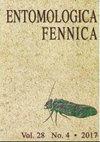雄性褐飞虱唾液腺的形态和超微结构(半翅目:膜总科)
Q3 Agricultural and Biological Sciences
引用次数: 0
摘要
雄性树蛙的唾液腺由一对腺泡状主腺组成,每个主腺有一个前叶和一个后叶;一对肘部形状的附属腺体。每个副腺通过一个薄的副唾液管与主腺相连。前叶包含三种类型的腺泡(I、II和III),而后叶只有一种类型的泡(IV)。两个传出唾液管融合成一个共同的唾液管。不同的腺泡细胞充满大小、数量、形状和电子密度不同的分泌颗粒,表明在分泌之前有一个成熟过程。不同腺泡中的信息表明物质在分泌前被稀释。腺泡IV和副腺管中微绒毛的存在可能表明分泌物正在成熟。副腺细胞内存在电子致密的细颗粒,可能与病毒传播有关。本文章由计算机程序翻译,如有差异,请以英文原文为准。
Morphology and ultrastructure of salivary glands of male treehopper Tricentrus brunneus Funkhouser (Hemiptera: Membracoidea)
The salivary glands of male treehopper Tricentrus brunneus Funkhouser comprise a pair of acinous principal glands each with an anterior lobe and a posterior lobe; a pair of elbow-shaped accessory glands. Every accessory gland connects with the principal gland via a thin accessory salivary duct. The anterior lobe contains three types of acini (I, II and III), whereas the posterior lobe possesses only one type of acinus (IV). Two efferent salivary ducts fuse into a common salivary duct. Different acinis cells are filled with secretory granules that are distinct in size, number, shape and electron-density, indicating a maturation process before secreted. Infoldings in different acini suggest dilution of substances before being secreted. The presence of microvilli in acinus IV and the accessory gland duct possibly indicates the undergoing maturation of secretions. Electron-dense fine granules existed in the accessory gland cells, possibly related to virus transmission.
求助全文
通过发布文献求助,成功后即可免费获取论文全文。
去求助
来源期刊

Entomologica Fennica
生物-昆虫学
CiteScore
1.20
自引率
0.00%
发文量
0
审稿时长
>12 weeks
期刊介绍:
Cessation.Information not localized
 求助内容:
求助内容: 应助结果提醒方式:
应助结果提醒方式:


